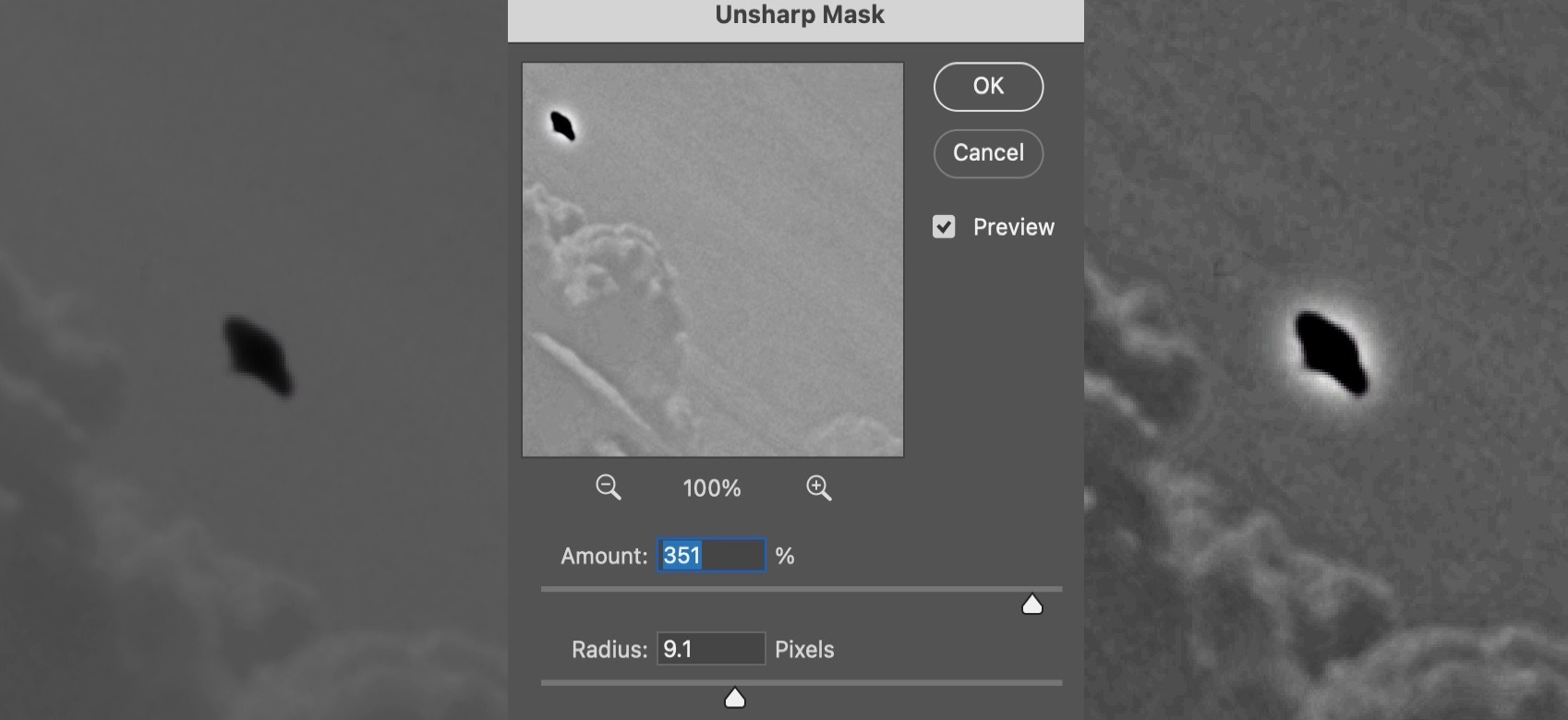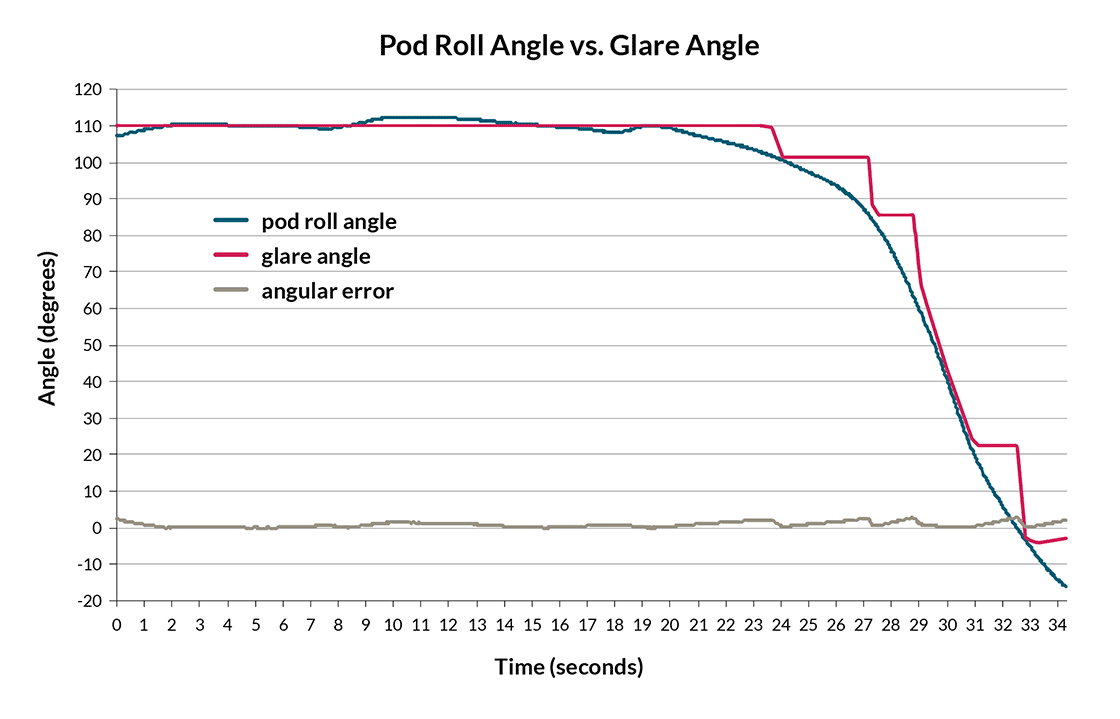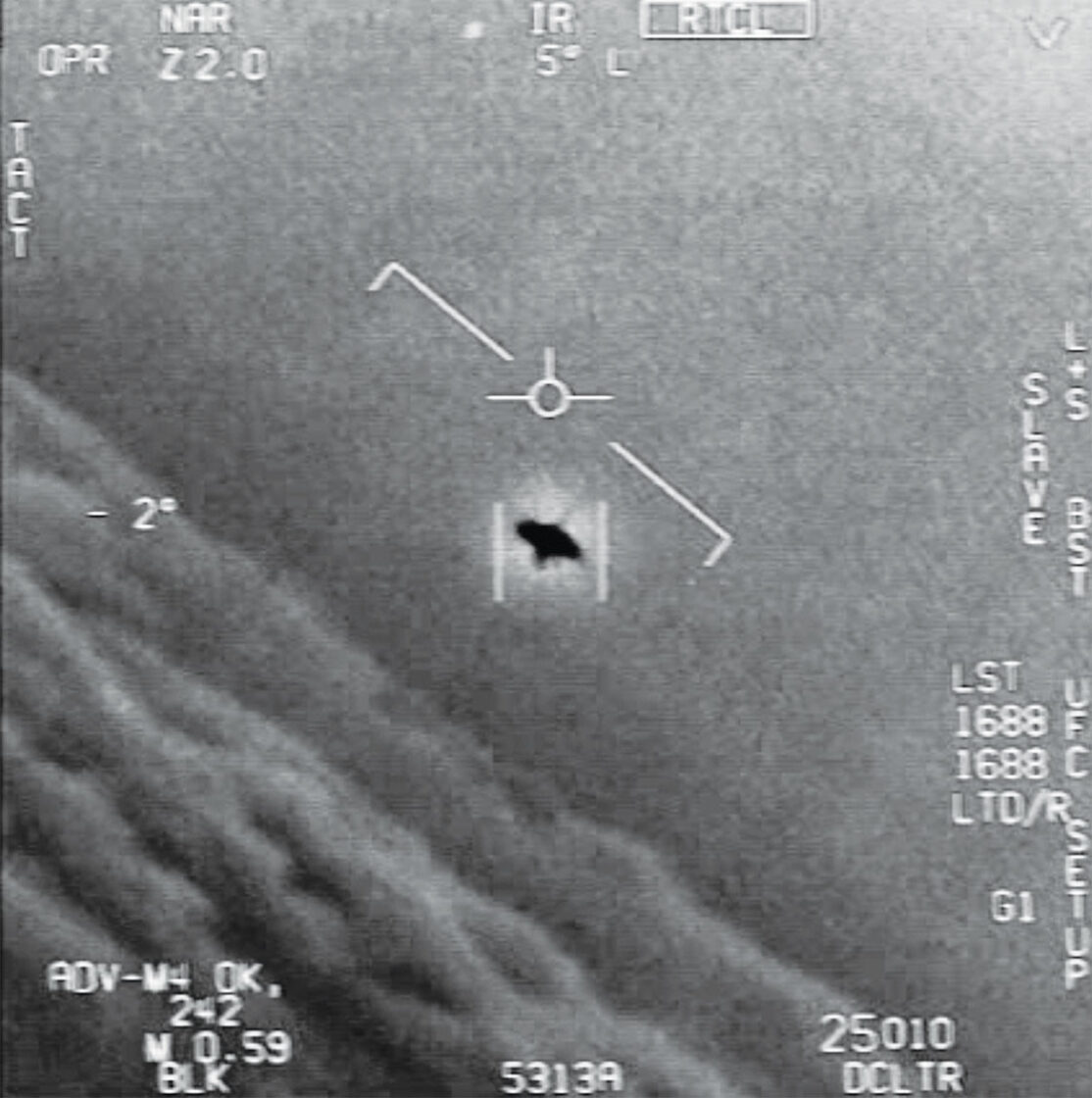In recent years, whenever you see a story on UFOs, it almost invariably includes images from the “Gimbal video,” a blurry monochrome clip of what vaguely looks like a flying saucer. Gimbal has rapidly become the dominant icon of the UFO/UAP (Unidentified Aerial Phenomena). Just keystroke “UFO” into a Google image search and a quarter of the results will be a frame from Gimbal.
The video first came to the public’s attention in December 2017, in a New York Times article1 authored by Helene Cooper (who covers the Pentagon for the Times), Ralph Blumenthal (who authored a biography of John Mack, a psychiatrist who studied those who claimed to be alien-abductees), and Leslie Kean (author of a bestselling UFO book). The online version of the story was headed by an embedded version of the video described as “an encounter between a Navy F/A-18 Super Hornet and an unknown object.”
This now-ubiquitous video is indeed interesting. It shows the view from the targeting pod on the F/A-18, which I’ll refer to as “the jet.” It’s thermal camera footage, so it is filming something that’s very hot in the middle of the screen, which I’ll refer to as “the object.” The object is roughly the shape of a classic flying saucer and appears to be flying rapidly to the left, just above the clouds. It seems as if it is surrounded by a bubble of cold air—termed “the aura.”
For the first 20 seconds of the video, not a lot is going on. But around 23 seconds weird things start to happen. There’s a little bump of the camera, and the object rotates a little counterclockwise. This happens three more times. During a particularly long rotation, one of the pilots in the plane says, incredulously, “look at that thing! It’s rotating!” The object continues to rotate until it’s past vertical, and inexplicably appears to slow down to a near stop.
If this were simply a video some guy took in his backyard, then it wouldn’t have received much attention outside of the UFO community. But Gimbal was radically different to anything the media had ever seen before. Here was a video not only being showcased by the New York Times, but also directly attributed to the Department of Defense. It became, therefore, nothing less than
the holy grail of UFO videos, an “official” video of an actual UFO; not simply some dot in the sky, but an actual flying saucer defying the laws of aerodynamics. UFOlogists were understandably elated, believing that at long last they had definitive evidence of alien visitation.
It’s Complicated
UFOs are often described as “unidentified” because conventional explanations—Identified Flying Objects—are sometimes difficult to pin down. Usually this is simply because the data are insufficient, but sometimes it’s because the analysis required is difficult and complex to perform, and even harder to understand. Even when the data set is adequately analyzed, sufficient ambiguities remain so that we cannot provide a convincingly definitive, mundane answer, thus leaving open the possibility of some unconventional explanation, which usually means “aliens.”
Skeptics recognize this problem as a form of the “God of the gaps” argument for the existence of God. Science has not answered every question about the universe, and many mysteries remain to be solved. Those mysteries, though shrinking in number, are taken by those “seeking something more” as evidence of something beyond science, i.e., God. And if not “God”, well, at least “Aliens.”
There are many questions we can attempt to answer about the Gimbal video. How big is the object? How far away is it? How fast is it moving? What is it? Why is it there? Who—if anyone (or anything) is on board? These are difficult questions to answer because of the lack of information. We might theorize it’s a misidentified small plane, but that’s difficult to prove or dismiss. So instead, I want to focus on those aspects of the video that seem, as some have claimed, to defy the limits of known aeronautic technology…and perhaps even physics itself. Let’s concentrate on what we can actually see and measure in the video—the flying saucer shape, the aura, and the rotation.
A Cold Aura?
Right out of the gate a mystery arose that seemed to defy physics. The New York Times included it in the headline (“Glowing Auras and Black Money”) precisely because it was so seemingly inexplicable. In the story they said the Gimbal was “an aircraft surrounded by some kind of glowing aura”—leaving unsaid the obvious point that no human aircraft does this, nor is there a physical mechanism possibly responsible for it. Others have described the aura as a “Possible energy or resonance field of unknown nature.”
However, it was soon apparent that the aura was in fact simply a common artifact of infrared cameras. Several other examples of the “cold” aura were found, including around red-hot jet engines and people. The effect could easily be duplicated with a common image-sharpening technique called an “unsharp mask.” It’s not mysterious at all, defies no laws of physics, but is simply a property of the photographic process and equipment.

The apparent “aura” is a common artifact of infrared cameras. This effect can be duplicated with a common image-sharpening technique called an “unsharp mask.”
It’s Rotating!
The object in Gimbal looks like it’s rotating. But is it?
The first thing to note is that the pilots are looking at the same thing we are looking at—a video. The event took place after dusk, and the object was not visible to the naked eye. So, when someone exclaims “it’s rotating,” he’s just giving his instant impression of a small video (the cockpit screens are tiny) that we’ve had the benefit of analyzing frame-by-frame for many hours on much larger screens.
Back on December 19, 2017, just two days after the publication of the video by the New York Times, I suggested that the rotation might be a camera artifact. I wrote: “I wonder if [the rotation] might be a function of the way the Raytheon ATFLIR works.” I then started on a series of experiments to try to establish how this could have happened.
A big clue here is the official name of the video: “Gimbal.” A gimbal system means one axis is mounted inside another. The simplest version being a Pan-and-Tilt camera, which can rotate to pan left-right, and then tilt up and down. The ATFLIR is similar, except it’s mounted horizontally, so instead of panning, it rolls. This is presumably done to make it more streamlined, but has the unfortunate effect of causing the image to rotate when, as in the Gimbal video, you track something from left to right.
So, might the U.S. Navy actually have figured it out? Is the rotation simply the result of the ATFLIR’s Gimbal mounting? I investigated further (with the help of others on Metabunk) and we found that the ATFLIR camera had a “derotation” mechanism, called a “dero.” The dero corrected any unwanted rotation in the image by making sure the horizon in the image was the same as the horizon out the window.
This correction process produces a curious side effect. Camera glare (the shape of light spilling out around a very bright or hot object) is relative to the camera. When you rotate the camera, the glare does not rotate, but the background (the horizon, clouds, etc.) does. Since we don’t want the rotation, the dero de-rotates the entire image back. Since the glare has not rotated, this dero action means the horizon does not rotate, but the glare does.
This is complicated, and hence somewhat difficult to explain. Over the last few years, I made several videos to help people understand what’s actually going on. While I convinced some people, others remained unmoved. I think this was largely due to the difficulty in understanding what was happening, along with my failure to explain it adequately.
A New Analysis
Four years after the video came out it was still going strong as the poster child for UFOs. Most new UFOlogy stories featured it, at least as a background graphic. So I felt I had to do something more and different. Given my background in 3D graphics (a former videogame programmer), I decided to brush the cobwebs off my 3D-math and create a new tool to simulate, analyze, and demonstrate what is going on in the video.
With the help of others on Metabunk, I extracted as much data from the video as was possible. The numbers on screen (the speed, heading, and elevation) were relatively simple—just scrolling through the video and typing them in. The bank angle of the jet was extracted using feature that tracks the ends of the artificial horizon. The angle of the actual Gimbal “object” (the saucer shape) was extracted using a combination of image analysis and manual keyframing.
With this data, I created a mathematical model of the ATFLIR camera mounting—and a 3D graphical model to display it in the simulator. I showed how the tracking of the camera from left to right would cause it to rotate. Now we could test the hypothesis: if the rotation on screen was actually from the camera rotating, then the angle of the camera roll should match the angle of the object. At first, while we could see it was all going in the right direction, it seemed as if the object was not rotating enough—and it was rotating in successive steps, rather than in a smooth curve.
We then noted two critical factors missing from our simulation: the jet’s own roll, and the pitch angle of the jet. Since the jet made some roll motions in the same direction the pod would need to roll, this reduced the amount of pod roll needed. Then, when the correct pitch of the jet was taken into account, the amount of roll was reduced even more, and we arrived at the graph reproduced below. The blue line is the expected roll, the red line is the rotation of the object (the glare). They follow very closely. But it’s actually a lot closer than it looks. The differences in roll (as much as 20°) result in very small angular differences in the actual line of sight of the camera. The amount of the error is shown by the gray line and remains under 3°.

Why the steps? The ATFLIR also has internal gimballed mirrors that can correct for small differences in the line of sight without having to use the heavy and inaccurate roll motors. These can account for 5°, so 3° is safely within the amount to be expected. And when you look at the steps in the graph, you see that it’s what you would expect if the roll only kicked in when the error gets above a certain level.
The result is a remarkable correlation. It means that if the rotating shape is the shape of a real object (and not just the glare from a real, non-rotating object) then it’s an object that rotates in a way that matches exactly the amount needed to stay within three degrees of a gimbal system tracking the target, while minimizing roll—but just from this one plane, at this pitch, and at this bank angle.
There are other observables in the Gimbal video. I used the simulator to try to explain all of them. Briefly, they are (1) the lack of rotation of the object in the first 20 seconds (when it should rotate with the background because the jet is banking); (2) the small camera bumps that occur before the rotation; and (3) a noticeable rotation of patterns of light in the sky during rotation of the object. It also looks like a glare, with typical right-angled diffraction spikes. Combined with the official name “Gimbal,” it seems like case closed.

This article appeared in Skeptic magazine 27.2
Buy print edition
Buy digital edition
Subscribe to print edition
Subscribe to digital edition
Download our app
Our analysis did not identify what the object is, but it disproves much ballyhooed media assertions, such as To the Stars Academy (TTSA) claim that “the object’s orientation and performance seem to defy current principles of physics to include atmospheric resistance and normal aerodynamic forces,” or even the New York Times’ more restrained observation that it is “rotating as it moves.” Careful analysis demonstrates there’s no evidence of new aerodynamics, and opens the door to more mundane possibilities, such as a misidentified jet. For a more detailed analysis see my analysis at Metabunk: “Gimbal UFO—A New Analysis.”2
Reactions
Not everyone agrees. Passions run high in the UFO community, and some members have continued to push back against the rather downto- earth explanation offered here. A few simply drop the “rotating” evidence, and claim it was never important anyway, with comments such as: “nothing more than a waste of time and effort. It adds no value and reaches no conclusion other than saying well it’s a glare and rotating.”
Some insist that the analysis is flawed and try to convince others in every way. Others, fortunately, have been willing to change their minds, as in this comment: “I’ll never forget the day of the Gimbal video drop. I thought that everything had changed, then your rebuttal video slapped my ego down. It was very bittersweet.”
While not a giant step for all skepticism, still a small step forward for critical thinking. ![]()
About the Author
Mick West is the author of Escaping the Rabbit Hole: How to Debunk Conspiracy Theories Using Facts, Logic, and Respect and the host of the podcast: Tales From The Rabbit Hole. Both focus on developing tools for understanding and helping people who have been sucked into conspiracy theories. He’s a retired videogame programmer who helped make the Tony Hawk’s Pro Skater Franchise. Mick also runs the website metabunk.org, where he investigates conspiracy theories, debunks pseudoscience, and analyzes UFO videos.
References
This article was published on August 2, 2022.















